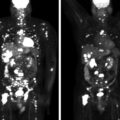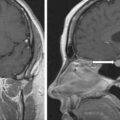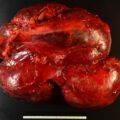Approximately 15% of patients with corticotropin (ACTH)-dependent Cushing syndrome (CS) have an ectopic source of ACTH secretion, with the most common source being a bronchial carcinoid (≈25%). Ectopic CS resulting from medullary carcinoma of the thyroid is rarer (2%–7.5% of ectopic CS cases). In patients with ACTH-dependent CS, rapid onset of CS and a known diagnosis of a metastatic medullary thyroid carcinoma suggest an ectopic origin of CS.
Case Report
The patient was a 31-year-old young man who was referred for management of CS. He was initially diagnosed with medullary thyroid carcinoma 17 years prior and was treated with a total thyroidectomy elsewhere. Subsequently (11 years before Mayo Clinic evaluation), he was diagnosed with a right pheochromocytoma and was treated with right adrenalectomy. At that time, genetic evaluation was pursued, and he was diagnosed with the multiple endocrine neoplasia (MEN) type 2B. The patient developed metastatic medullary thyroid carcinoma and received multiple treatments over the past 10 years, including repeat neck exploration and resection of lymphadenopathy; chemotherapy with vandetanib, cabozantinib, and lenvatinib; as well local radiation therapy for liver metastases.
Five months before evaluation, he started developing symptoms consistent with CS. On physical examination, moon facies, supraclavicular and dorsocervical fat pads, facial erythema, and proximal myopathy were documented. No striae or acne were observed. Multiple mucosal neuromas were visible.
INVESTIGATIONS
The laboratory test results are shown in Table 58.1 . ACTH-dependent hypercortisolism was documented based on elevated levels of ACTH, midnight salivary cortisol, and 24-hour urine cortisol. A pituitary origin of ACTH was considered less likely because of the rapid onset of hypercortisolism, suspected link to the metastatic medullary carcinoma, and negative pituitary imaging on review of brain magnetic resonance imaging performed for cancer staging purposes. In addition, on review of abdominal imaging ( Fig. 58.1 ), left adrenal nodularity was demonstrated and suspected to represent pheochromocytoma associated with MEN2B. Workup for catecholamine excess was obtained but was negative ( Table 58.1 ).
| Biochemical Test | Result | Reference Range |
| 4 pm serum cortisol, mcg/dL | 18 | 2–14 |
ACTH, pg/mL | 100 | 7.2–63 |
DHEA-S, mcg/dL | 144 | 57–552 |
24-Hour urine free cortisol, mcg | 303 | <45 |
Midnight salivary cortisol, ng/dL | 193 | <100 |
Plasma metanephrines, nmol/L | 0.45 | <0.5 |
Plasma normetanephrines, nmol/L | 0.28 | <0.9 |
Stay updated, free articles. Join our Telegram channel

Full access? Get Clinical Tree








